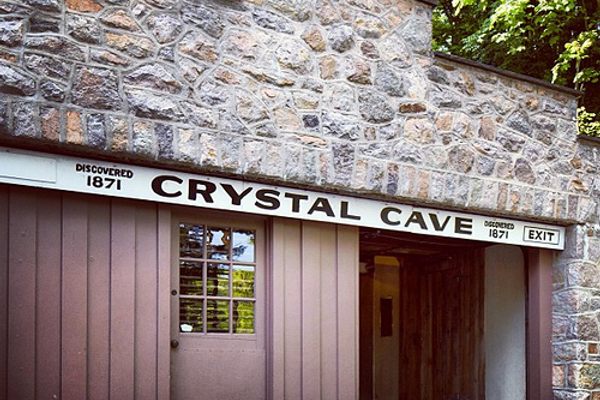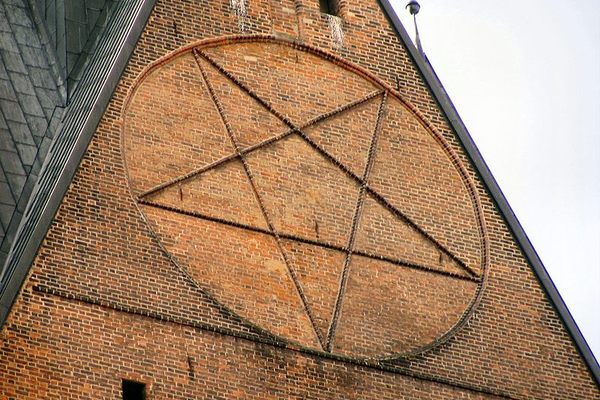Folk Magic: The Hex Signs of Pennsylvania
An eight-pointed barn star in Berks County (photograph by Anne Delong)
In 1952, a Berks County folk artist named Johnny Ott started painting and selling colorful, stylized discs inspired by the large, decorative stars that commonly adorned the barns across Pennsylvania German Country (still colloquially known as Pennsylvania Dutch Country). Unlike barn stars, which were painted directly on the sides of structures, the wooden hex signs, a term likely derived from the Pennsylvania German word “hexafoo” or “witch’s foot,” could be ported around and hung not just on barns, but anywhere. Ott marketed hex signs as objects of folk magic, ascribing specific meaning and power to the symbolism on the signs.
Barn stars (photograph by Anne Delong)
If you believe in that kind of thing, four- and five-pointed stars conjure good luck. Eight-pointed stars conjure fertility or abundance. Two distelfinks — the Pennsylvania German word for goldfinches — conjure love and happiness in marriage. Sixteen points bring prosperity. A bird of paradise means welcome. The rosettes and stars of a “Daddy Hex” ward off famine. Oaks and acorns bring strength.

A barn with hex signs in Lehigh County (photograph by Nicholas A. Tonelli)
While Ott wasn’t the first person to make the barn star designs portable — that probably happened in 1950 when Kutztown Folk Festival director Dr. Alfred Shoemaker and artist Milton Hall responded to festival-goers desire to purchase barn stars — Ott’s emphasis on magical properties popularized the signs to such an extent that they have become emblematic of Pennsylvania German Culture. Today, hand-painted hex signs appear not just on barns but homes and businesses all over Southeastern Pennsylvania, and mass-produced versions can be had at pretty much every gift shop and decorate tourist attractions like Crystal Cave and Roadside America. Each year, the Kutztown Folk Festival brings together the best hex sign artists in celebration and commerce. Additionally, local convention and visitors centers in Berks and Lancaster counties offer maps and self-guided tours of authentic hex sign locations, and local artists continue the tradition of hand painting and restoring the signs.
Fractur with birds, star, and flowers (via Brooklyn Museum)
Although the aesthetic of the region, with its clapboard churches, Amish buggies, antique stores, and bucolic farms, leans toward the quaint rather than the creepy, artistic expressions of folk magic and nature symbolism have a long history among the Pennsylvania German. As an agrarian community dependent on the cycle of nature, artists incorporated geometric designs associated with the circle of life and divinity into elaborate, illuminated documents, such as birth and marriage certificates. This folk art form, known as Fractur, was practiced primarily between 1740 and 1860 and often contained images and symbols that would later appear in hex signs.
Barn with a hex sign in Chester County (photograph by Smallbones/Wikimedia)
The artistic tradition of decorating barns with folk symbols began as early as the late 1700s and became even more popular as paint became less and less expensive. The original barn stars were found mostly in Berks County, and also in Lancaster, Montgomery, and Bucks counties, and pre-20th century examples can still be found there today. One of the earliest known examples, located two miles north of Lenhartsville, Pennsylvania, dates back to 1819, though the paint has faded and it’s only left the “ghost” of the design etched in the barn wood.
Because they are so heavily associated with Pennsylvania German Country, many people incorrectly assume the Amish developed and use hex sign iconography. “Plain Dutch,” such as Amish and Mennonites, reject the hex signs as superstitious or pagan. Barn stars and hex signs are rather used by the more secular “Fancy Dutch” community of Pennsylvania Germans, which exists alongside the Amish and Mennonites.
Stars on a yellow barn in Lancaster County (photograph by Gerry Dincher)
Still, the signs remain controversial. Many in the Fancy Dutch community embrace the hex signs for their beauty and tradition, but insist that the signs have no magical powers and were never legitimately used as such. Artist Milton Hill disagreed with Johnny Ott’s assertions that the signs were magic and coined the phrase “chust for nice” with respect to the signs, meaning they are simply decorative. Other hex sign painters argue that while the symbols are powerful, they are Christian symbols and therefor acceptable for use by Christians. That, however, has not stopped neopagans from enthusiastically adopting hex signs as part of their own religious practices and believing the symbols and their ascribed meanings to be ancient.
Hex signs on a red barn in Lehigh County (photograph by Nicholas A. Tonelli)
The pagan aspect is partially correct since some of the symbolism used in hexing has its roots in Teutonic Paganism, including pentagrams, hexagrams, and octagrams. Yet, in the same way that Christmas trees and Easter eggs were appropriated by Christians, so was star symbolism.
Medieval Christians used the pentagram to symbolize the feast of the epiphany, which commemorates the three Magi arriving to visit the Christ child. The seat of the Lutheran Church in Hanover, Germany, which dates back to the 1400s, still has a pentagram emblazoned on its tower — a bit of iconography that provokes much comment by visitors unaware that the pentagram, which is now primarily associated with neopaganism, was once used by Christians.
A barn star (photograph by Anne Delong)
It’s now widely accepted that it was via the folk traditions of medieval German Christians, brought to Pennsylvania by their Lutheran ancestors, that eventually gave rise to hex signs and barn stars. Whether their magic is literal or figurative, they remain a powerful symbol of Pennsylvania’s distinct and complex German heritage.
CONVINCED OF THE HEX:
ROADSIDE AMERICA, Shartlesville, Pennsylvania
CRYSTAL CAVE, Kutztown, Pennsylvania
MARKTKIRCHE, Hanover, Germany































Follow us on Twitter to get the latest on the world's hidden wonders.
Like us on Facebook to get the latest on the world's hidden wonders.
Follow us on Twitter Like us on Facebook